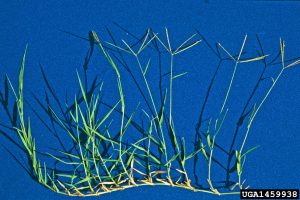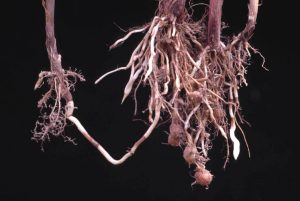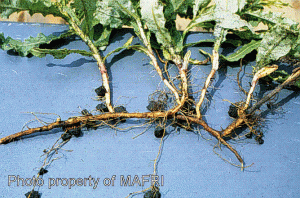Chapter 3: Vegetative Reproduction
3.3 Vegetative Forms of Reproduction
We will now look closer at the different types of vegetative tissues which plants can use to reproduce. The five tissue types to be discussed include: rhizomes, stolons, tubers, bulbs, and modified roots. They vary by their location (above or below the soil surface), as well as their origination (root or stem tissues). Let’s start first with rhizomes.
Rhizomes

Plants that are able to produce via rhizomes can actually grow and reproduce faster than those which rely solely on seeds to reproduce. This is because seeds require time to germinate and establish themselves as seedlings. In contrast, rhizomes utilize nutrients from the mother plant to immediately grow new plants.
Key features of rhizomes:
- Rhizomes grow horizontally, underground through the soil.
- Rhizomes are stem tissues. Even though they grow in the soil, they are not root tissue.
- Aside from aiding in the spread and reproduction of the mother plant, rhizomes store carbohydrates produced from the mother plant’s photosynthesis. Actively growing rhizomatous plants have a lot of vegetative structure and high levels of photosynthesis occurring. Throughout the growing season they will send carbohydrates from the leaves down into the rhizomes for storage. During the winter and early spring, or if the above ground vegetative tissue is damaged, the plants will rely on this stored reserve for fueling regrowth.
Examples of plants with rhizomes: Reed canarygrass (Phalaris arundinacea L.), Jerusalem artichoke (Hellanthus tuberosus)
Stolons

Like rhizomes, stolons are also stem tissue from which new plants can propagate. However, stolons are not located below the soil surface, but instead are found on top of the soil. If you have ever seen strawberry plants growing, this is an example of plants with stolons. Stolons are also called “runners”.
Key features of stolons:
- Stolons grow on top of the soil.
- Stolons are stem tissues.
- They only function to spread and reproduce plants, they do not store significant amounts of carbohydrates.
Examples of plants with stolons: Bermudagrass (Cynodon dactylon (L.) Pers), strawberry (Fragaria ananassa)
Review and Reflection
Tubers

A third type of vegetative propagule is called tubers. Tubers are stem tissue and similar to rhizomes, are located below the soil surface.
Key features of tubers:
- Tubers are underground stem tissues.
- Found at the end of a rhizome or root tissue.
- Function to store carbohydrates and also reproduction/spreading.
Example: Jerusalem artichoke (Hellanthus tuberosus, has both tubers and rhizomes) Yellow nutsedge (Cyperus esculentus L.) (Side note: This is a common weed in many lawns. Homeowners often make the mistake of pulling these weeds later in the season, which only adds to the problem, by leaving the tubers in the soil because they break off as the mother plant is pulled.)
The following drawings from the University of California Integrated Plant Management program illustrates nicely the differences between these 3 types of vegetative propagules. Pictured below clockwise, beginning top left: stolon, tuber, rhizome.
Bulbs

The fourth type of vegetative propagule we will talk about are bulbs, which are not stem tissues, but instead are modified leaves.
Key features of bulbs:
- Bulbs are located below the soil surface.
- They are modified leaf tissue.
- They store carbohydrates, in addition to functioning to spread and reproduce plants.
Example of plants with bulbs: Wild garlic (Allium vineale L.), onion (Allium cepa)
Modified Roots

The final type of vegetative tissue that plants can reproduce by are modified root structures. Instead of being stem tissue like rhizomes, these are true roots. They do not have any nodes or internodes, like stems do. Instead, they have adventitious buds, from where they can form new plants. If a plant with modified roots is mowed, the adventitious buds will generate new plants.
Key features:
- They are modified root tissue and are located below the soil surface.
- Adventitious buds will produce new plants.
Examples of plants with modified roots: Common milkweed (Asclepias syriaca) and Canada thistle (Cirsium arvense)